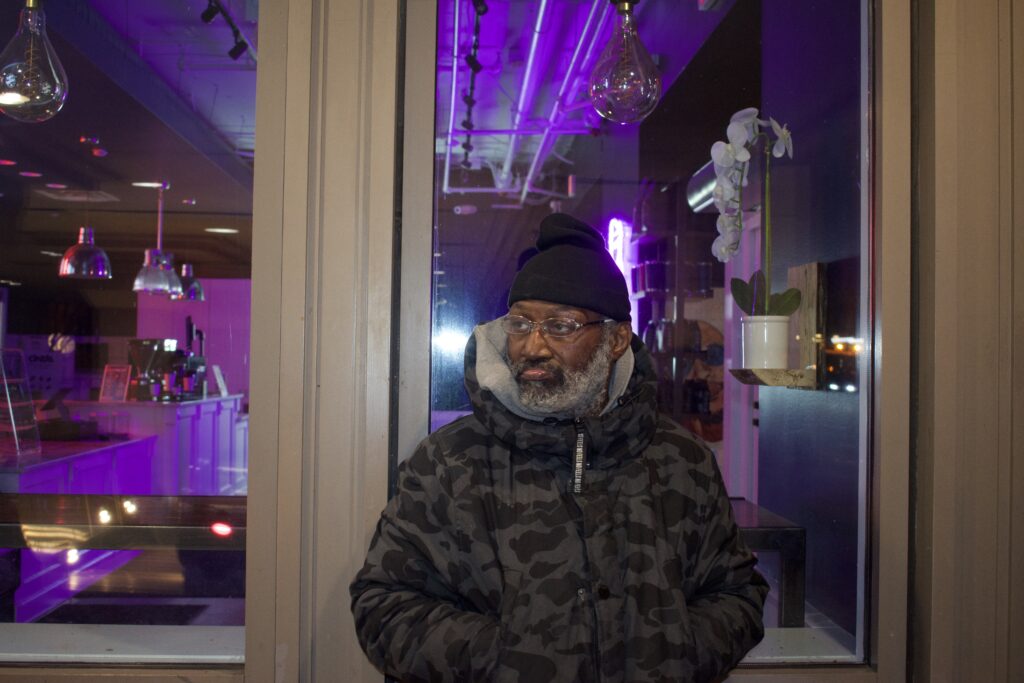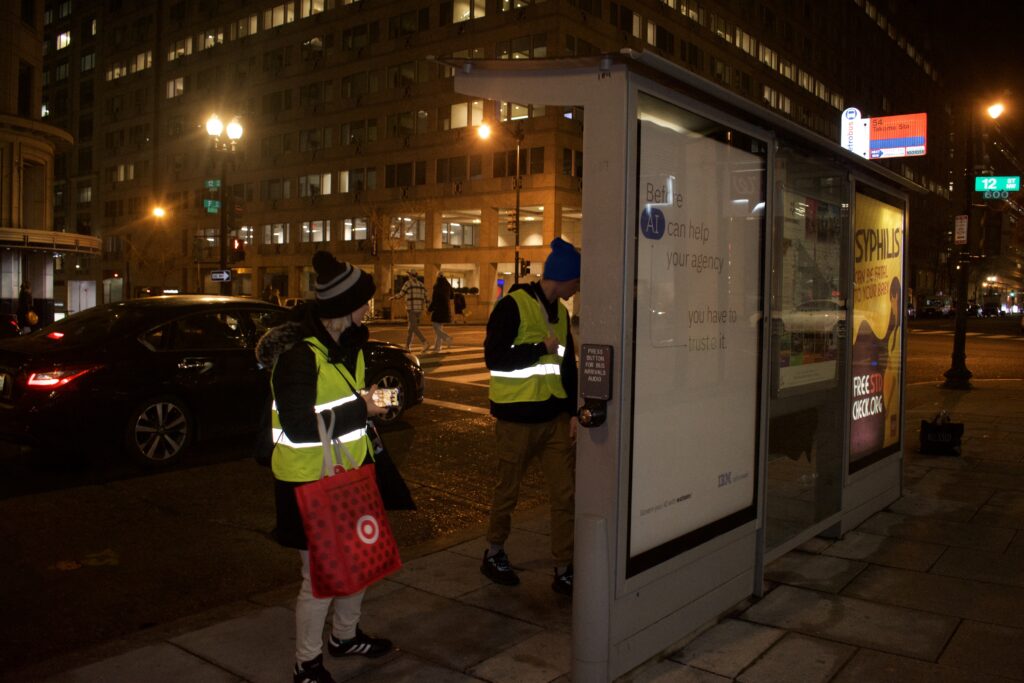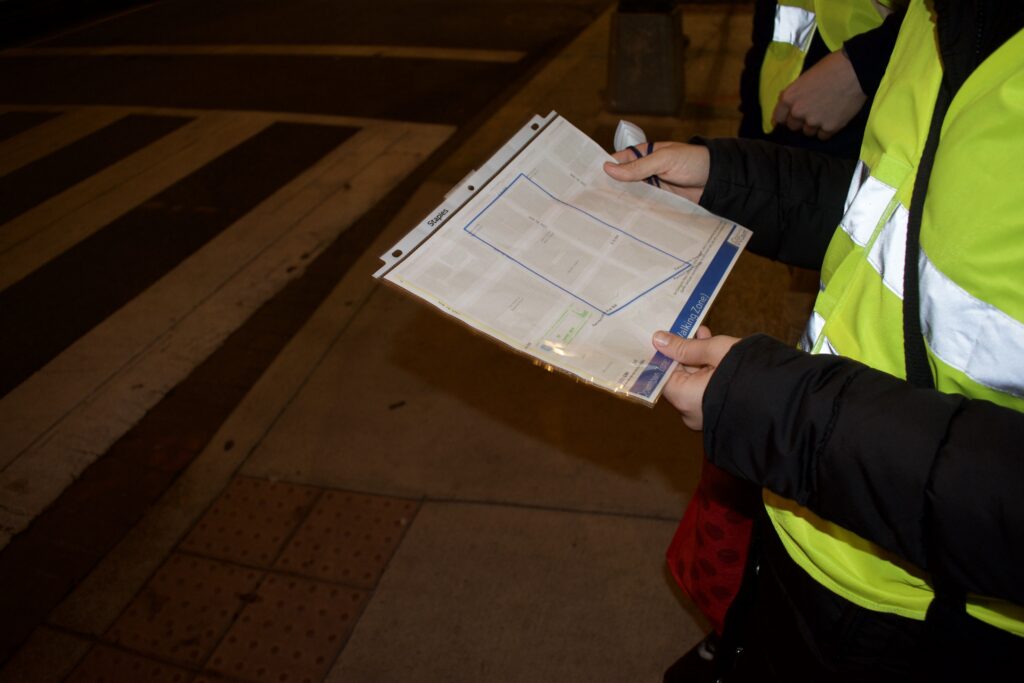Michael Broughton, equipped with Visa gift cards and a bright blue beanie, set out from the First Congregational United Church of Christ around 9 p.m. on Jan. 24.
A D.C. Pathways to Housing program manager, Broughton was leading a team of volunteers to survey people sleeping outside in downtown D.C. for the annual Point-in-Time (PIT) Count.
One of the first people Broughton surveyed was Vernon, whom he met standing beneath the awning of the 13th Street entrance to the Metro Center station. As Vernon spoke to Broughton, and then to Street Sense, he kept his eyes on the nearby sidewalk. He said he was looking for someone who’d give him money for some food and water.
“I’m trying my best,” Vernon said. “It don’t seem like it, but I’m trying.”
Conducted every January, the PIT Count is a federally-mandated survey of people experiencing homelessness nationwide. Like in D.C., surveyors in cities and states around the country went out on Jan. 24, counting everyone sleeping in a shelter, on the street or in other places not intended for habitation.

It was Vernon’s first time being surveyed for the PIT Count — he got out of jail after 16 and a half years in early December. He said he could have stayed with his mom, but she’s older and he hoped he’d be alright on his own. Vernon said he’s gotten used to people ignoring him when he asks for money, so he appreciated that the survey gave him a chance to share his thoughts.
“Get out here and talk to the homeless people and see what they need and meet them where they’re at,” he said. For Vernon, that was housing assistance for people who were recently released from prison, and aid to buy basic needs, like food and water.
That’s one of the goals homeless service workers and volunteers had the night of D.C.’s PIT Count: To understand what led to people experiencing homelessness, and the kind of support they might need to find housing again.
Last year, for the first time since 2016, homelessness in D.C. increased, according to the 2023 PIT Count. Since D.C. launched its plan to end homelessness eight years ago, the number of people experiencing homelessness on any one night in D.C. has somewhat steadily decreased, largely driven by reductions in the number of families experiencing homelessness.
Despite these efforts, homelessness increased by about 12% in the District in 2023, and even more across the Washington region. Much of that increase was from people experiencing homelessness for the first time.
After a year full of changes to the homeless services system, the 2024 PIT Count offers a chance to see where homelessness in D.C. currently stands.
While D.C. has invested more resources into ending chronic homelessness by moving hundreds of people who have been on the streets for years into apartments, resources to prevent people from entering homelessness, like D.C.’s Emergency Rental Assistance Program (ERAP), haven’t met demand. The Department of Human Services (DHS), which administers most homeless services programs, is facing mid-year cuts, with an expectation that funding may again decrease next year.
Once the 2024 PIT Count results come out this spring, D.C.’s government officials will use them to decide how much the city will spend on ending homelessness over the next year.
“This is not just an interesting exercise that we’re doing, we’re doing this with people’s lives,” Christy Respress, CEO of Pathways to Housing said. “The onus is on us as a community to do something with this data.”
The PIT Count also offers a chance to see how current homeless service and prevention programs are performing, Respress said.
In fiscal year 2022, D.C. funded a record number of vouchers for individuals experiencing homelessness. Though it took years for some people to move into housing with those vouchers, DHS Director Laura Zeilinger said at the kick-off for the PIT Count hosted by Pathways that the city helped about 1,000 people exit homelessness over the last year. But that doesn’t mean the total number of people experiencing homelessness is guaranteed to go down, as she added “yet we still see more and more people on our streets.”
Broughton said he was curious to see if there’s another increase in people experiencing homelessness for the first time, like Vernon, especially as resources like ERAP run dry. He works for Pathways at the Downtown Day Services Center, and said he was trying to help people apply for ERAP, but knew several who couldn’t.

One man came to the center, saw the portal was down, and left, not knowing that by the time he checked the website again, funds would have run out.
“I think the work Pathways does at the ground level is incredible and makes a huge difference,” Broughton said. “But the answer is always going to be more affordable and deeply affordable housing. The hope is that this type of insight leads to changes that make our job easier in the sense that we have more resources to do what we do.”
While the PIT Count is the main way jurisdictions track progress toward ending homelessness and compare efforts across the country, it isn’t perfect. The count captures people who are staying in shelters and those who sleep outside and are visible when volunteers walk by — like those staying outside metro stations, in parks or along major streets in D.C.
Broughton’s team spoke to people outside stores and sleeping in bus shelters. But those who may sleep somewhere harder to find, like in a car or abandoned building, are often missed by the count.
SchoolHouse Connection posits this can especially lead to undercounts in family homelessness, since visible family homelessness can lead to parents losing custody of their children. The count can miss people who may spend one night or primarily stay with friends, families, or in hotels. And, there are always some people who don’t want to talk to surveyors, though they’re still included in the number.
“The reality is that I’m coming up to an individual at 10 o’clock at night and they’re trying to get sleep,” Broughton said. “They might not want to have a conversation with me, which is valid. All of that combined shows where you might miss people along the way.”
In addition to sheer numbers, the PIT Count also gives insight into the specifics of the region’s homeless population. Some details don’t change year to year, Respress said, like the fact that people of color are disproportionately affected by homelessness, or that people need support addressing substance use and mental health. But this year, providers are looking out for one big change: Where people are sleeping.
Outreach providers consistently report that as the city and National Park Service have closed encampments over the past year, people who sleep outside have moved away from downtown to places harder to find, like Rock Creek Park. This can make it difficult to provide case management and to find people during the PIT Count.
“I’m interested to see where folks have moved,” said Jessie Henry, Pathways’ associate director of homeless services, adding that Pathways has seen fewer people downtown after encampment closures like at McPherson Square Park. “I’m interested to see the other areas in D.C. [where] they see the most folks.”
Pathways primarily serves the downtown area, Broughton said, and several volunteers said they were surprised at how few people were out on Jan. 24. While the hope is always that people have moved to housing, Henry’s worried people have moved to harder-to-find places.
“I think people are nervous to be downtown, because there’s no space left, and because of the closures, so it does just push people out further,” Henry said.
While the PIT results are always important, this year feels especially significant. Many resources D.C. funded to end homelessness have finally kicked in, which Respress hopes will show a decrease in homelessness as people move into housing. But she also knows the results are needed to advocate for continued funding for social services as D.C. enters a lean year.
Funding to end homelessness in D.C. is dependent on two factors. The PIT Count determines how much funding the city receives from the federal government, though federal funding is partially dependent on the results of the presidential election, Respress said. There’s also the local budget, determined by the mayor and D.C. Council. Last year, D.C. funded voucher and prevention programs below what advocates saw as their true need, and with Bowser already passing mid-year cuts on to providers, there’s a worry funding will decrease again, making it more difficult to end homelessness.
Speaking to the crowd of about 100 people gathered at the First Congregational United Church of Christ before the PIT Count began, At-Large Councilmember Robert White, who chairs the council’s housing committee, underlined this concern.
“The largest part of the progress that we have to make is on the prevention side,” he said, highlighting resources like ERAP, the Supplemental Nutrition Assistance Program, and Temporary Assistance for Needy Families, programs the council has advocated funding largely against the will of Bowser.
When the PIT results come out this spring, Pathways and other organizations will use them to advocate to keep funding programs that are helping to end homelessness.
“At the end of the day, if there aren’t enough resources and people are entering the system, it means you’re going to see more people on the street,” Henry said. “People are going to need support and they’re not going to get it.”








